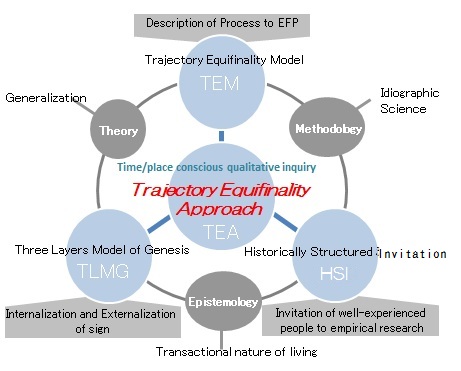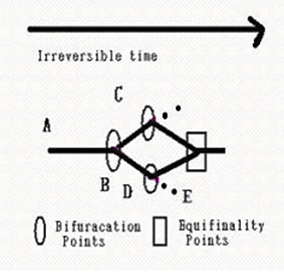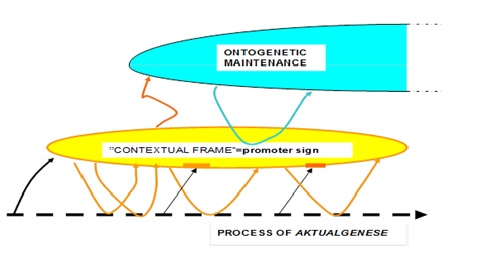 SATO, Tatsuya, Ph.D.
SATO, Tatsuya, Ph.D.Ritsumeikan University
TEA is a triarchic construction in cultural psychology which consists of three sub-components. These are the Historically Structured Sampling (HSS), Trajectory Equifinality Model (TEM) and Three Layer Model of Genesis (TLMG).
Historically Structured Sampling (HSS)
HSS is a methodological tool of sampling for qualitative inquiry.HSS is inevitably related to Equifinality Point (EFP) as a research focus. Researchers set their spontaneous interesting research focus by themselves (neither obeying professor's instruction nor reading antecedent references). Then HSS makes it possible to pick up participants who experienced an Equifinality point while arriving there through very different life course trajectories (neither random sampled people nor college students).
Trajectory Equifinality Model (TEM)
TEM is a methodology for describing life within irreversible time and is the flagship of TEA.It has some basic notions, such as Bifurcation Point (BFP), Equifinality point (EFP) and Trajectory. The notion of irreversible time originates in Henri Bergson's philosophy, and is a premise of TEM.

Three Layer Model of Genesis (TLMG)
TLMG is related to (Bifurcation Point) BFP. TLMG is a framework for understanding the transactional nature of signs as they are organized into a working in dialogical system of self at the levels of microgenesis, mesogenesis, and ontogenesis. Here it is implied that self is not homogeneous entity but complex process of different voices. TLMG makes it possible to understand how signs emerge at a particular time and place (i.e., at bifurcation) in a life trajectory.

Core Publications(in English)
Valsiner, J. & Sato, T. (2006). Historically Structured Sampling (HSS):
How can psychology's methodology become tuned in to the reality of the historical nature of cultural psychology?
In Straub, J. , K?lbl, C. , Weidemann, D. & Zielke, B. (Eds.) Pursuit of meaning.
Advances in cultural and cross-cultural psychology(pp.215-251). Bielefeld: Transcript Verlag.[Downlord]
Sato, T., Hidaka, T. & Fukuda, M. (2009). Depicting the Dynamics of Living the Life: The Trajectory Equifinality Model.
In J. Valsiner, P. Molenaar, M. Lyra and N. Chaudhary (Eds),
Dynamic process methodology in the social and developmental sciences (p. 217‐240). New York: Springer.[Downlord]
Sato, T. (2011). Minding Money: How Understanding of Value is Culturally Promoted.
Integrative Psychological and Behavioral Science, 45, 116-131. [Downlord]
Sato, T., Yasuda, Y., Kanzaki, M. & Valsiner, J. (2014/forthcoming).
From Describing to Reconstructing Life Trajectories:
How the TEA (Trajectory Equifinality Approach) explicates context-dependent human phenomena.
Cultural Psychology and Its Future: Complementarity in a New Key
[Downlord]
Related Publications
Valsiner, J. (2001). Comparative study of human cultural development. Madrid: Fundacion Infancia y Aprendizaje.Sato, T. and J. Valsiner (2010). Time in life and life in time: Between experiencing and accounting. Ritsumeikan Journal of Human Sciences(立命館人間科学研究) 20(1): 79-92.[Downlord]